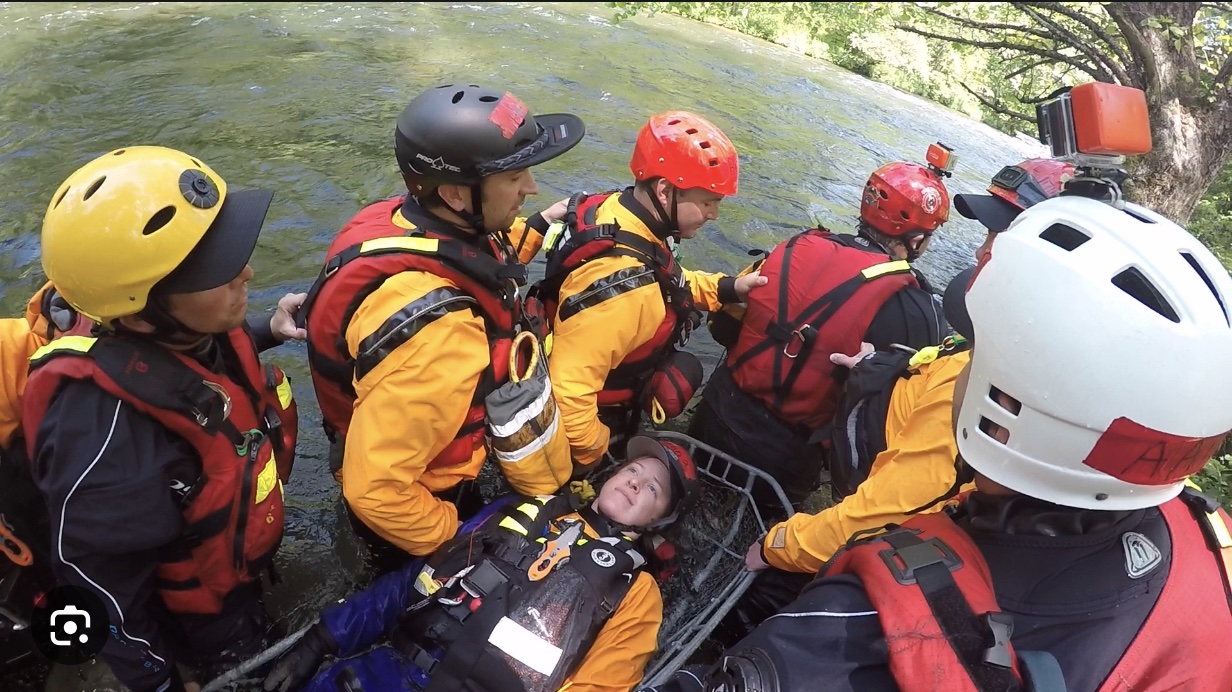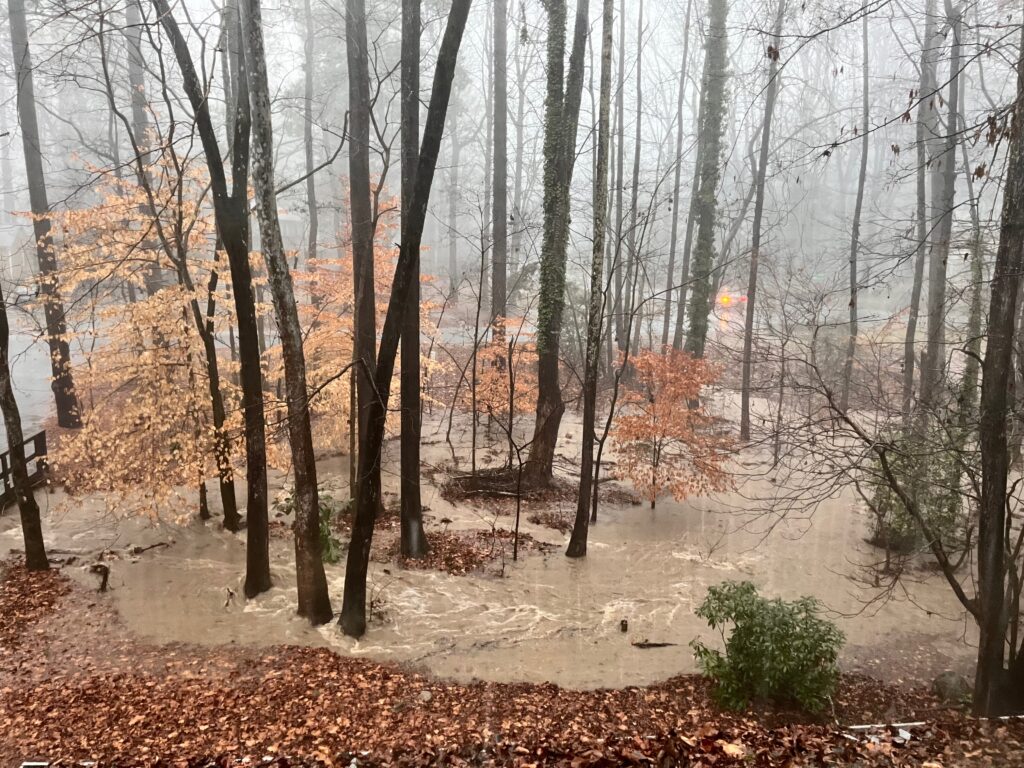How To Stay Safe in High Water and Flooding
By Assistant Chief Josh Asbill and Volunteer Margot Lester
Heavy rain events are occurring more frequently and with more severity. Here in Orange County, we’ve definitely seen an uptick in the number of flooding-producing storms in the last few years. If conditions become dangerous enough, our Technical Rescue Team is dispatched alongside local departments to rescue people.
And it’s not just here in Orange County. The entire state is experiencing episodes of extreme moisture, often bookended and made worse by episodes of extreme dry. According to the North Carolina State Climate Office, “With periods of severe drought immediately followed by heavy rain and flooding, 2024 featured more examples of weather whiplash. That’s a term we coined back in 2021 to describe the quick, unpredictable changes in our weather, particularly between wet and dry spells.”
Fact: NASA data show that this back-and-forth is a global phenomenon.
The reality is that we are all being impacted by heavy rain events more frequently. That’s why, regardless of where you live, work or play, you need to know how to stay safe when the water gets high.
Stay out of the water
The easiest way to stay safe is to stay out of the water. You need reasons? We got ‘em.
The most common misconception of floodwater is that it’s just water. But when the water comes up, especially when it rises high and fast, it gets where it shouldn’t, like companies that store chemicals for their businesses, wastewater treatment plants and that sketchy shed where your uncle keeps the paint stripper, solvents and who knows what else. If the rain comes during a drought, pollutants on the ground and roadways—like fertilizers, pesticides, herbicides, and vehicle fluids like antifreeze and motor oil—float around in there, too. There could also be bacteria and little critters swept up in the current and looking for something to latch onto.
Fact: It takes as little as 6 inches (basically over your ankles) of moving water to knock you down.
So when you walk through that water or fall all the way into it, you risk exposure to what all’s in there. Ick. This is why water rescue teams like our swiftwater squad wear drysuits to prevent or limit exposure to these hazards during rescue operations.
And it’s not just the yuck. Rising water can also include floating debris like wood, glass or metal that you can’t always see coming. Did we mention downed power lines? They could be in there, too. Additionally, drains and culverts overwhelmed by the stormwater can cause people to suddenly get pulled in and potentially get stuck.
It’s easy to think you’re safer in a vehicle, but you’ve seen the videos. Those aren’t isolated incidences. “Turn around. Don’t drown” isn’t just a slogan. Standing and moving water may hide hazards like high curbs, bollards and debris or washouts that can submerge you and your ride.
Fact: A vehicle can start to float in just one foot of water and 6 inches can stall you out or make you lose control.
And although it’s tempting, keep the watercraft in the garage until the waters recede. We don’t want to get to know you by pulling you out of a tree on the Haw or because you and your kayak got stuck in a culvert.

The SORS TRT volunteers train regularly to be ready for swiftwater and other technical rescue scenarios. Photo courtesy of SORS
Do this when someone is caught in the water
If someone is caught in the water, the safest way to help is to not go in after them. It feels counterintuitive, but you can’t get them to safety by putting yourself in danger. Here’s what to do:
- Stay out of the water.
- Get help. If someone else is there, ask them to keep their eyes on the person and call 9-1-1. If you’re alone, call 9-1-1 yourself.
- Reach out to them. Extend a branch, board or broomstick for them to grab onto so you can try to pull them to dry land. Don’t lean over too far and if you feel yourself falling toward the water, let go.
- Throw to them. Toss something that floats, like a ball or cooler, to help them stay above water. Bonus points if it’s got a rope attached so you can haul them in. Remember to let it go, however, if you feel like you’re going to go in, too.
Be ready for flooding and high water
It’s much easier to prepare for rising water before the rain arrives. Here are some questions to consider:
- Does the area around your home or workplace flood during heavy rains? Explore landscaping and stormwater mitigation tactics that can reduce dangerous runoff, standing water and flooding. Tip: Local government stormwater departments consult with residents and business owners.
- Do the roadways you frequent flood? Identify alternate routes so you can get where you need to go without encountering high water. Tip: Print out the alternate routes since cell service may be out during severe weather.
- How would you know if conditions were right for a possible flood or high water event? Sign up for emergency alerts from the County and notices from your favorite weather app. Tip: The U.S. Geological Survey has gauges on many of our creeks and rivers. Find out what water levels indicate rising water near you.
- Do you have what you need if an evacuation order is issued? Collect vital documents and items for personal and pet go-bags. Tip: NC Emergency Management has a helpful list.
And remember that with extreme weather, anywhere—even locations the flood maps show as low-risk—can flood. That’s why these preparations are important for everyone.

This is a flash flood in Margot’s front yard in January 2024 caused by an intense rainstorm. Photo courtesy of Margot Lester
Our TRT and EMS members train to respond when you need us, and we’ve been doing it for more than half a century. We take rising and rushing water seriously and want you to, too.
The South Orange Rescue Squad’s Technical Rescue volunteers respond with local fire departments to assist with evacuations and deploy to emergency rescue calls at local recreational waters like the Haw River. We also assist with emergency response across the state. Learn more about the TRT and how to support SORS.
 The South Orange Dispatch is a monthly column on Chapelboro by the South Orange Rescue Squad: an all volunteer, 501c3 non-profit providing EMS and technical rescue services in the Carrboro-Chapel Hill area of Orange County since 1971.
The South Orange Dispatch is a monthly column on Chapelboro by the South Orange Rescue Squad: an all volunteer, 501c3 non-profit providing EMS and technical rescue services in the Carrboro-Chapel Hill area of Orange County since 1971.


